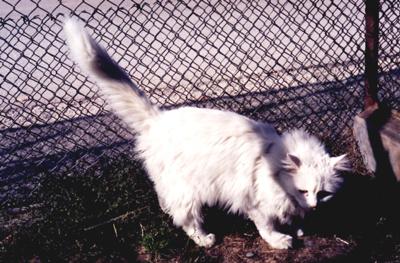by Harvey Harrison
(Lapta, Mersin 10, Turkey)

Turkish Angora Ankara Zoo
The first thing that catches one's attention is that the Ankara Zoo Turkish Angoras do not look very much like the contemporary Turkish Angoras and not even like the older variety of the Western cat fancy.
What could be the explanation?
The complete prohibition on the export of TAs from Turkey and even DNA samples, would have obliged breeders to breed time and time again from a very small genetic pool leading to serious inbreeding.

Another larger format version to show the cat clearly
Instead of that I suggest that outcrossing to other breeds was undertaken with the resultant change in appearance and DNA marker.
Nevertheless, the findings of the UC Davis Genome Project determined that the contemporary Turkish Angora (TA) is more closely related to the Egyptian Mau and to Tunisian cats than to cats with Turkish DNA.
They only trace a distant relationship to the Turkish Van but with influences from Italy, Israel and Egypt.
There is nothing simple about the ancestry of the contemporary TA. The DNA markers of the Turkish Van and the Turkish Angora from the Ankara Zoo are virtually identical explaining their identical appearance.
I have sent further photos of Ankara Zoo Turkish Angoras which will no doubt be published shortly.
Harvey
From First we should know what Turkish Turkish Angoras look like to Turkish Angora cat

this is my princess waffle, I fostered her then she became part of our family. I thought she was Maine coins. the vet says Australian long hair . but I’m seeing and reading Turkish angora . will someone tell me what they see ? thank you so much. she has one blue eye and one goldgreen
Renee, I have seen Maine Coons look like this. Her muzzle is not really like a Maine Coon’s but the rest of her looks Maine Coon. “Australian Longhair” is a fairly meaningless description if you live in America. If you live in Australia, “Australian Longhair” means a random bred cat living in Australia which is probably correct. What she or he is saying is that the cat is a longhaired random bred cat. That said there is a bit of Maine Coon about her as you say.
Without registration and a pedigree we have to guess from appearance and don’t forget that the genes of Angoras have travelled far and wide so random bred cats have a mix of genes in them. The obvious conclusion is that she is a beautiful longhaired random bred cat who resembles (to a certain extent) a Maine Coon. Thanks for visiting Renee.
Thanks Michael. The photo was taken when he was still very much a kitten but a very lucky one. . Unlike many rescued kittens he is very healthy and on top of that very friendly and sociable with people. Just great for establishing a new line of Genuine Turks. He behaved very well at his first show in Istanbul where he got 2 CACs (Champion) straight off. before he went to the USA. His mate is an all white green eyed beauty who also got 2 CACs at the same show
@Lisa James. There is one difficulty in recognising TAs as such in the cat fancy. I think that all cat registries require that cats to be recognised as TAs must prove their Turkish ancestry. When the DNA markers show that they do not have Turkish ancestry as in the case of most American pedigree TAs, how did they prove their Turkish ancestry? Any cat from Turkey will have the East Mediterranean Anatolian markers not the Western group markers. This indicates either some bending of the rules or false exportation documents presented by the breeder(s). On another matter, I have recently exported a breeding pair of TAs to Texas. I and the new owner would like to know which societies in America prefer the Zoo look on the show bench so as to avoid any clash of preferences.
That’s a gorgeous cat Harvey.
Turkish angora,s are considered a purebred. They shall be all black or all white. long tail,thick maine,less allergetic,and less shedding because of their rectangularish hair from folicles.They do like water and are very much kike,’miss mew’
Hi Kelly. Pure-bred TAs in the USA and Europe are not pure-bred at all. They are an amazing mishmash of many breeds from different continents but mainly from the Western grouping. TA’s in Turkey including the Ankara/Kecioran Zoo are not “pure-bred” but they are pure. Figure that out.
More Ankara Zoo cat pictures can be found here:
Use them the way you like.
Thank you very much. I will publish them here. Fantastic. I prefer the Turkish Angora in Turkey. More pure! More genuine.